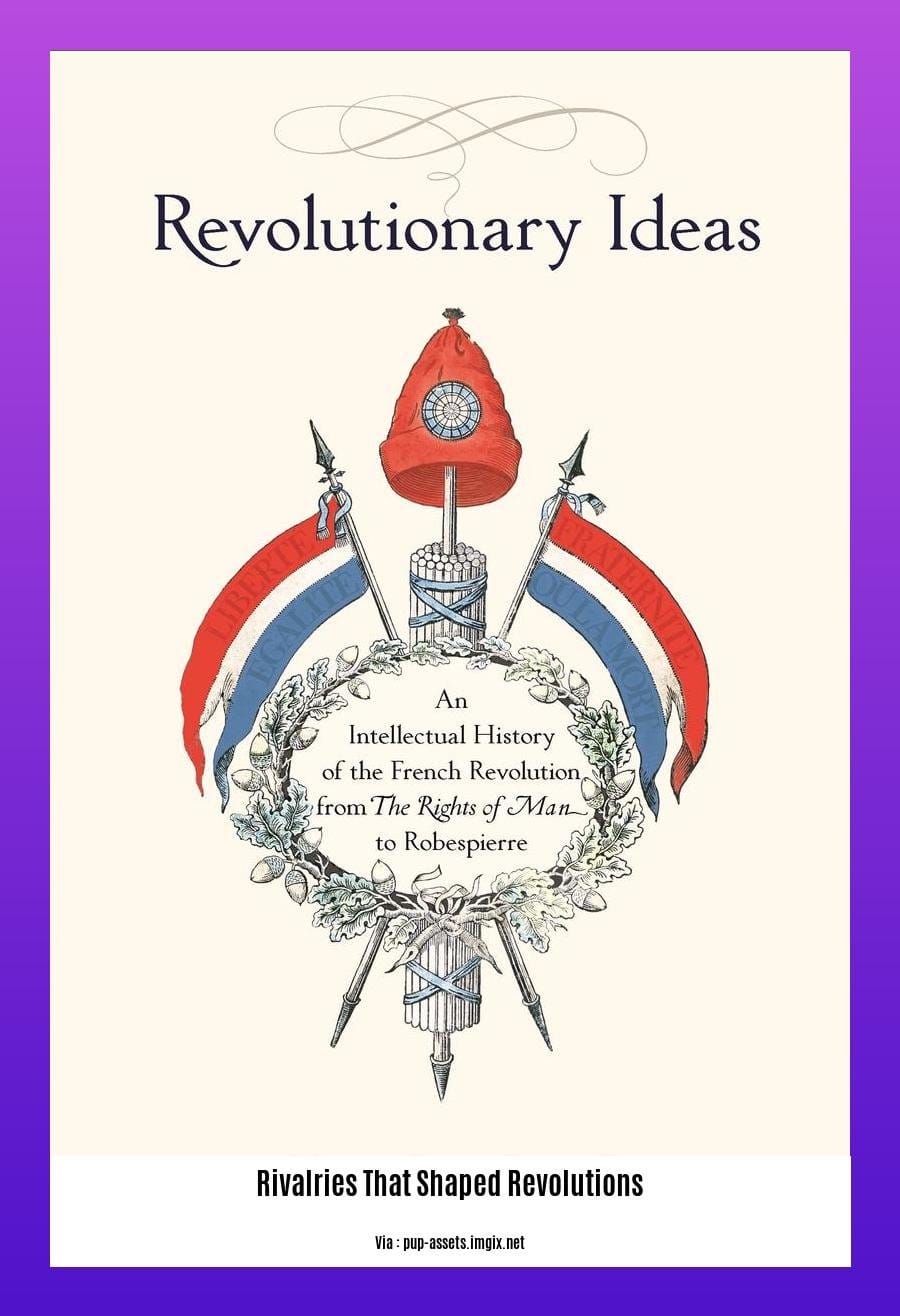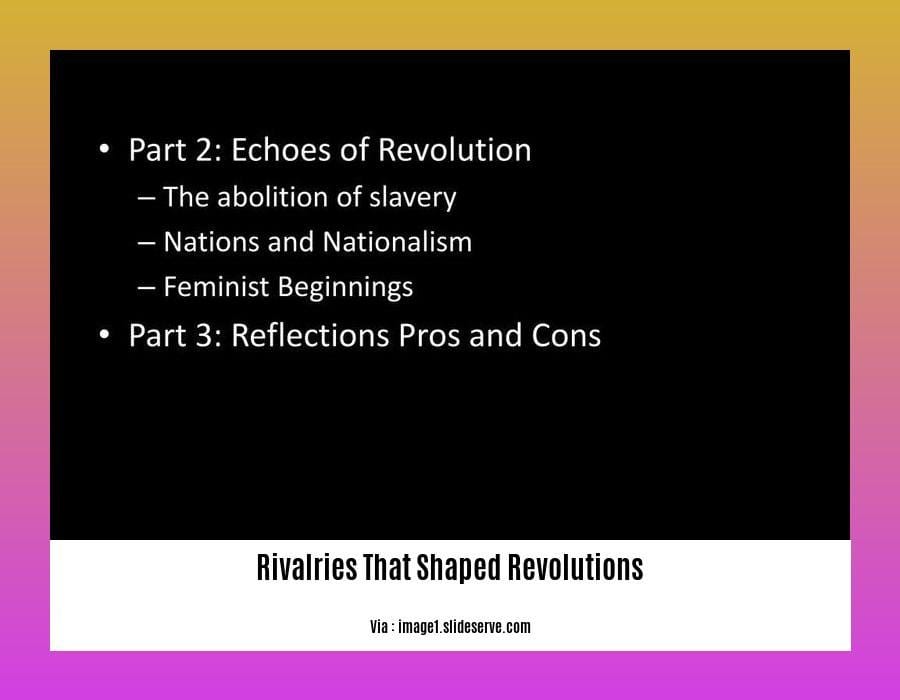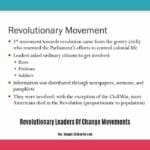Uncover the hidden stories behind the revolutions that shaped our world in “Rivalries That Shaped Revolutions: A Historical Analysis.” Dive into the riveting narratives of rivalries that fueled revolutionary movements, from personal ambitions to ideological clashes and geopolitical power plays. Explore how these dynamics influenced the outcomes of revolutions, shaping the course of history as we know it.
Key Takeaways:

- Rivalries between nations, classes, and individuals have significantly influenced the course and outcomes of revolutions.
- Tensions caused by economic disparities, political oppression, and social injustice can fuel revolutionary movements.
- Rivalries can also hinder revolutions by dividing leaders, creating factions, and weakening collective efforts.
- Personal ambitions, ideological differences, and geopolitical factors can shape the nature and intensity of rivalries within revolutionary movements.
- Understanding the interplay of rivalries is crucial for comprehending the complexities and dynamics of revolutions throughout history.
Rivalries that Shaped Revolutions
Throughout history, rivalries that shaped revolutions have played a significant role in their emergence, trajectory, and outcomes. These rivalries, often driven by personal ambitions, ideological conflicts, or geopolitical interests, have both fueled and hindered revolutionary movements.
Personal Rivalries
Rivalries between individuals have often ignited the spark of revolution. In the American Revolution, the personal animosity between George Washington and King George III fueled the tensions that escalated into armed conflict. Similarly, in the French Revolution, the rivalry between Robespierre and Danton led to the Reign of Terror.
Ideological Rivalries
Ideological differences can also drive rivalries that shaped revolutions. The Russian Revolution was fueled by the rivalry between the Bolsheviks and Mensheviks over the path to socialism. Likewise, in the Chinese Revolution, the rivalry between Mao Zedong and Chiang Kai-shek over communist versus nationalist ideologies shaped the conflict.
Geopolitical Rivalries
Geopolitical factors can also play a role in rivalries that shaped revolutions. In the Haitian Revolution, the rivalry between France and Britain over control of the Caribbean influenced the course of the conflict. Similarly, in the Cold War era, the rivalry between the United States and the Soviet Union had a profound impact on revolutions in various parts of the world.
The Impact of Rivalries on Revolutions
The impact of rivalries that shaped revolutions can be both positive and negative. On one hand, rivalries can provide the impetus for change by fueling dissent and mobilizing support for revolutionary ideas. On the other hand, rivalries can also lead to division, infighting, and ultimately hinder the success of revolutions.
Understanding the role of rivalries that shaped revolutions is crucial for comprehending the complexities of these historical events. By examining the motivations, dynamics, and consequences of these rivalries, we can gain deeper insights into the forces that have driven social and political transformations throughout history.
Discover the fierce rivalries and intense feuds that plagued the revolutionary era, as we delve into the revolutionary peers and their intense rivalries that shaped history.
Explore the complex relationships and feuding revolutionary counterparts and contemporaries who fought for their beliefs and challenged each other’s authority.
Uncover the famous rifts between contemporary revolutionaries that shook ideologies and divided movements, leaving a lasting impact on the course of revolutions and their legacies.
Geopolitical Factors and External Rivalries
Delving into the intricate tapestries of history, I’ve uncovered the profound impact of geopolitical factors and external rivalries on the course of revolutions. These external forces often act as catalysts, fueling the flames of discontent and shaping the very fabric of these transformative events.
The Mantle of Geopolitics
Geopolitics encompasses the complex interplay between geography, economics, and power dynamics on the global stage. When these elements collide, they can create fertile ground for geopolitical rivalries. These rivalries arise as nations jostle for strategic advantage, control of resources, or ideological dominance.
External Rivalries: A Revolutionary Spark
External rivalries involve states outside a particular geographic or ideological region. They can exert significant influence on revolutions, often intensifying the conflict and introducing new power dynamics. For instance, during the Haitian Revolution, France and Britain’s rivalry played a pivotal role in the colony’s struggle for independence.
Types of External Rivalries
External rivalries can manifest in various forms:
- Spatial: Disputes over territory
- Ideological: Conflicts driven by differing political-economic beliefs
- Interventionary: Attempts by one state to control the politics of another
Power Dynamics in Rivalry
In many cases, external rivalries are asymmetrical, with one state holding a significant power advantage over the other. This imbalance can both fuel and hinder revolutionary movements. On the one hand, it can provide support and resources to rebels; on the other, it can also intensify repression and escalate the conflict.
Key Takeaways:
- Geopolitics and external rivalries are potent forces that can shape the course of revolutions.
- External rivalries can introduce new power dynamics and intensify conflict.
- The type of rivalry (spatial, ideological, or interventionary) influences its impact on revolutionary movements.
- Asymmetrical power dynamics in rivalries can have both positive and negative effects on revolutions.
Most Relevant URL Source:
- Great Strategic Rivalries: The Return of Geopolitics
Effects of Rivalry on Unity and Cohesion
Throughout the annals of history, rivalries have played a profound role in shaping the trajectories of revolutions. These contentious relationships, often anchored in personal ambitions, ideological clashes, or geopolitical factors, can both fuel revolutionary movements and hinder their progress. Let’s explore the complex Effects of Rivalry on Unity and Cohesion.
Personal Rivalries
At the heart of many revolutions lie personal rivalries that ignite the spark of discontent. For instance, the bitter feud between George Washington and King George III played a pivotal role in galvanizing the American colonists to seek independence. Such rivalries can fan the flames of resentment and provide a rallying point for the disaffected.
Ideological Rivalries
Ideological differences can also fuel revolutionary movements. The ideological rivalry between the Bolsheviks and Mensheviks, for example, deeply divided the Russian revolutionaries and ultimately contributed to the protracted nature of the Russian Revolution. Competing ideologies can create fault lines within revolutionary groups, making it difficult to maintain a cohesive front.
Geopolitical Rivalries
Geopolitical rivalries, such as the competition between France and Britain during the Haitian Revolution, can have a significant impact on revolutionary movements. External powers may provide support or hinder revolutionary efforts based on their own strategic interests. These rivalries can create complex alliances and dependencies that can alter the course of revolutions.
Unity and Cohesion
Rivalries can both foster and hinder unity and cohesion within revolutionary movements. On the one hand, they can create a sense of common purpose and solidarity against a shared adversary. Shared experiences and sacrifices can strengthen bonds between revolutionaries. On the other hand, rivalries can also sow division and discord within revolutionary ranks. Personal ambitions or ideological differences can lead to infighting and undermine the movement’s unity.
Key Takeaways:
- Rivalries can ignite revolutions by fostering resentment and providing a rallying point.
- Ideological differences can divide revolutionary movements and make it difficult to maintain cohesion.
- Geopolitical rivalries can influence the course of revolutions by providing external support or hindrances.
- Rivalries can both foster and hinder unity and cohesion within revolutionary movements.
Citation:
Examples of Rivalries from Historical Revolutions
Throughout the annals of history, revolutions have unfolded as gripping tales of power struggles, ideological clashes, and geopolitical tensions. These upheavals have often been fueled by bitter rivalries, both personal and political, which have shaped their trajectories and outcomes.
Personal Rivalries
Ambitious leaders, clashing egos, and personal vendettas have ignited the flames of revolution. George Washington and King George III‘s rivalry during the American Revolution epitomizes this phenomenon. Washington’s charismatic leadership and determination to free the colonies from British rule stood in stark contrast to King George’s stubborn refusal to grant autonomy. This personal animosity fueled the conflict and ultimately led to America’s independence.
Ideological Rivalries
Sharp divisions in political and economic beliefs have also played a pivotal role in revolutions. In the Russian Revolution, the Bolsheviks and Mensheviks clashed over the path to social change. The Bolsheviks, led by Vladimir Lenin, advocated for a radical seizure of power, while the Mensheviks preferred a more moderate approach. This ideological rivalry split the revolutionary movement and contributed to the eventual Bolshevik victory.
Geopolitical Rivalries
The interplay of international relations has often influenced the course of revolutions. During the Haitian Revolution, France and Britain fiercely competed for control over the Caribbean. This rivalry fueled the Haitian struggle for independence, as both European powers sought to use the revolution to their advantage. Ultimately, Haiti emerged as the first independent Black republic in the Americas, thanks in part to the geopolitical dynamics of the era.
Key Takeaways:
- Rivalries can fuel revolutions by providing a catalyst for dissent and mobilization.
- Personal, ideological, and geopolitical rivalries have played significant roles in shaping revolutionary movements.
- Understanding rivalries is crucial for comprehending the complexities of historical revolutions.
Most Relevant URL Source:
- World Atlas:
















